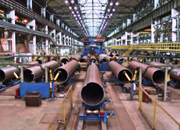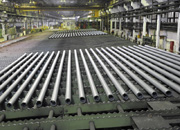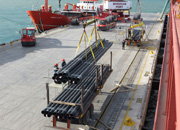Q890C straight seam welded steel pipe is a high-strength, low-alloy structural steel welded pipe widely used in engineering machinery, mining equipment, bridge construction, high-pressure vessels, and other fields. This steel pipe, with its excellent mechanical and weldability properties, has become an indispensable material in modern industry.
First, the material characteristics and standard requirements of Q890C straight seam welded steel pipe.
Q890C belongs to high-strength quenched and tempered steel, with a yield strength ≥890MPa and a tensile strength reaching 940-1100MPa. It also possesses good low-temperature impact toughness (maintaining high toughness even at 40℃). This material conforms to GB/T 16270-2009 "High-Strength Structural Quenched and Tempered Steel Plate" standard. Through the addition of microalloying elements such as niobium, vanadium, and titanium, combined with controlled rolling and controlled cooling process (TMCP), fine-grain strengthening and precipitation strengthening are achieved, thus ensuring both high strength and weldability. Weldability is one of the core advantages of Q890C straight seam welded steel pipe. Its carbon equivalent (Ceq) is typically controlled between 0.45% and 0.55%, and cold cracking sensitivity is reduced through optimized chemical composition. Furthermore, post-weld hydrogen removal treatment or local preheating (recommended preheating temperature 150-200℃) is required to prevent hydrogen-induced cracking. Some high-end applications also require overall quenching and tempering (quenching + tempering) of the steel pipe to further improve its comprehensive performance.
Second, the production process and technical challenges of Q890C straight seam welded steel pipe.
The production of Q890C straight seam welded steel pipe mainly includes four stages: steel plate pretreatment, forming welding, heat treatment, and inspection.
1. Steel plate pretreatment: Ultrasonic testing is used to ensure the base material is free of internal defects, and the edges need to be milled to ensure welding quality.
2. Forming welding: The mainstream processes are JCOE (progressive forming) or UOE (union forming), combined with multi-wire submerged arc welding (SAW) technology. The welding current needs to be precisely controlled to avoid degradation of the heat-affected zone (HAZ).
3. Heat Treatment: For thick-walled steel pipes (e.g., wall thickness ≥ 20mm), online medium-frequency induction heating or offline overall tempering is required to eliminate residual stress and improve microstructure uniformity.
4. Non-destructive Testing: 100% ultrasonic testing (UT) and X-ray testing (RT) are performed in dual verification. For some harsh conditions, hardness testing and Charpy impact testing are also required.
The technical challenges lie in the control of the welding process. For example, welding heat input must be limited to 1525kJ/cm; excessive heat input will lead to HAZ grain coarsening, significantly reducing toughness. Furthermore, the weld reinforcement needs to be ground smooth to reduce stress concentration, which is crucial for subsequent anti-corrosion coating application.
Third, Typical Application Scenarios and Cases of Q890C Straight Seam Welded Steel Pipes.
1. Construction Machinery: As a core material for crane booms and pump truck booms, Q890C straight seam welded steel pipes can reduce equipment weight by more than 20%. Some leading companies have already adopted this type of steel pipe in large quantities for their high-end models.
2. Energy Transportation: Used in ultra-high pressure oil and gas pipelines (such as reinforced sections of X80 and higher grade steel pipelines), its resistance to hydrogen sulfide corrosion is certified by NACE TM0177 standard.
3. Special Vehicles: Used in scenarios such as roll cages for military armored vehicles and main beams for mining dump trucks, utilizing its high specific strength to achieve a balance between lightweighting and safety.
It is worth noting that in the Shenzhen-Zhongshan Bridge project, which opened to traffic in 2024, some steel box girder reinforcement ribs used Q890C straight seam welded steel pipes, with a fatigue life exceeding 2 million cycles, far exceeding that of conventional Q690 materials.
Fourth, Market Status and Development Trends of Q890C Straight Seam Welded Steel Pipes.
According to data from the China Iron and Steel Association, the domestic market size of Q890C high-end welded steel pipes exceeded 800,000 tons in 2024, with an annual growth rate of 12%. With the advancement of the "dual carbon" target, the demand in emerging fields such as wind turbine towers (especially offshore wind power) and hydrogen energy storage and transportation equipment is rapidly increasing. From a technological perspective, future development directions include:
- Intelligent manufacturing: Using laser vision-guided welding robots to increase weld pass rate to over 99.9%;
- Composite processes: Exploring the application of laser-arc composite welding in thick-walled steel pipes (≥40mm);
- Green manufacturing: Developing chromium-free passivation anti-corrosion coating technology to meet EU REACH regulations.
Fifth, Recommendations for the Selection and Use of Q890C Straight Seam Welded Steel Pipes
When purchasing Q890C straight seam welded steel pipes, users should pay close attention to the following:
1. Certifications: Whether it has passed international certifications such as API 5L/ISO 3183;
2. Test reports: Require suppliers to provide mechanical performance reports from third-party testing institutions (such as SGS, BV);
3. Anti-corrosion solutions: Select a suitable coating system (such as epoxy coal tar, 3PE, or polyurethane coating) according to the usage environment.
During use, direct welding should be avoided in environments below 50℃, and high-temperature shaping processes such as flame straightening are not recommended. For structures subjected to alternating loads, magnetic particle testing (MT) is recommended every 5 years to assess potential fatigue cracks.
In summary, Q890C straight seam welded steel pipe, with its excellent balance of strength and toughness, is reshaping the high-end steel structure industry chain. As China's manufacturing industry transforms towards high-quality development, the application potential of this material in cutting-edge fields such as aerospace and deep-sea equipment remains to be further explored. In the next five years, Q890C straight seam welded steel pipe, with its lightweight and long-life characteristics, may become one of the important carriers of "new quality productivity" in the materials field.
 Threeway Steel is known as a professional supplier engaged in manufacturing and distributing a wide range of steel pipe, and our headquarter located the central part of China – Hunan and six associated factories throughout China.
Threeway Steel is known as a professional supplier engaged in manufacturing and distributing a wide range of steel pipe, and our headquarter located the central part of China – Hunan and six associated factories throughout China.
 Threeway Steel is known as a professional supplier engaged in designing, manufacturing and distribution of a wide range of steel products with the headquarter located the central part of China – Hunan and six associated factories throughout China.
Threeway Steel is known as a professional supplier engaged in designing, manufacturing and distribution of a wide range of steel products with the headquarter located the central part of China – Hunan and six associated factories throughout China.
 Threeway Steel is known as a professional supplier engaged in designing, manufacturing and distribution of a wide range of steel products with the headquarter located the central part of China – Hunan and six associated factories throughout China.
Threeway Steel is known as a professional supplier engaged in designing, manufacturing and distribution of a wide range of steel products with the headquarter located the central part of China – Hunan and six associated factories throughout China.
 Threeway Steel is known as a professional supplier engaged in designing, manufacturing and distribution of a wide range of steel products with the headquarter located the central part of China – Hunan and six associated factories throughout China.
Threeway Steel is known as a professional supplier engaged in designing, manufacturing and distribution of a wide range of steel products with the headquarter located the central part of China – Hunan and six associated factories throughout China.
 Threeway Steel is known as a professional supplier engaged in designing, manufacturing and distribution of a wide range of steel products with the headquarter located the central part of China – Hunan and six associated factories throughout China.
Threeway Steel is known as a professional supplier engaged in designing, manufacturing and distribution of a wide range of steel products with the headquarter located the central part of China – Hunan and six associated factories throughout China.

